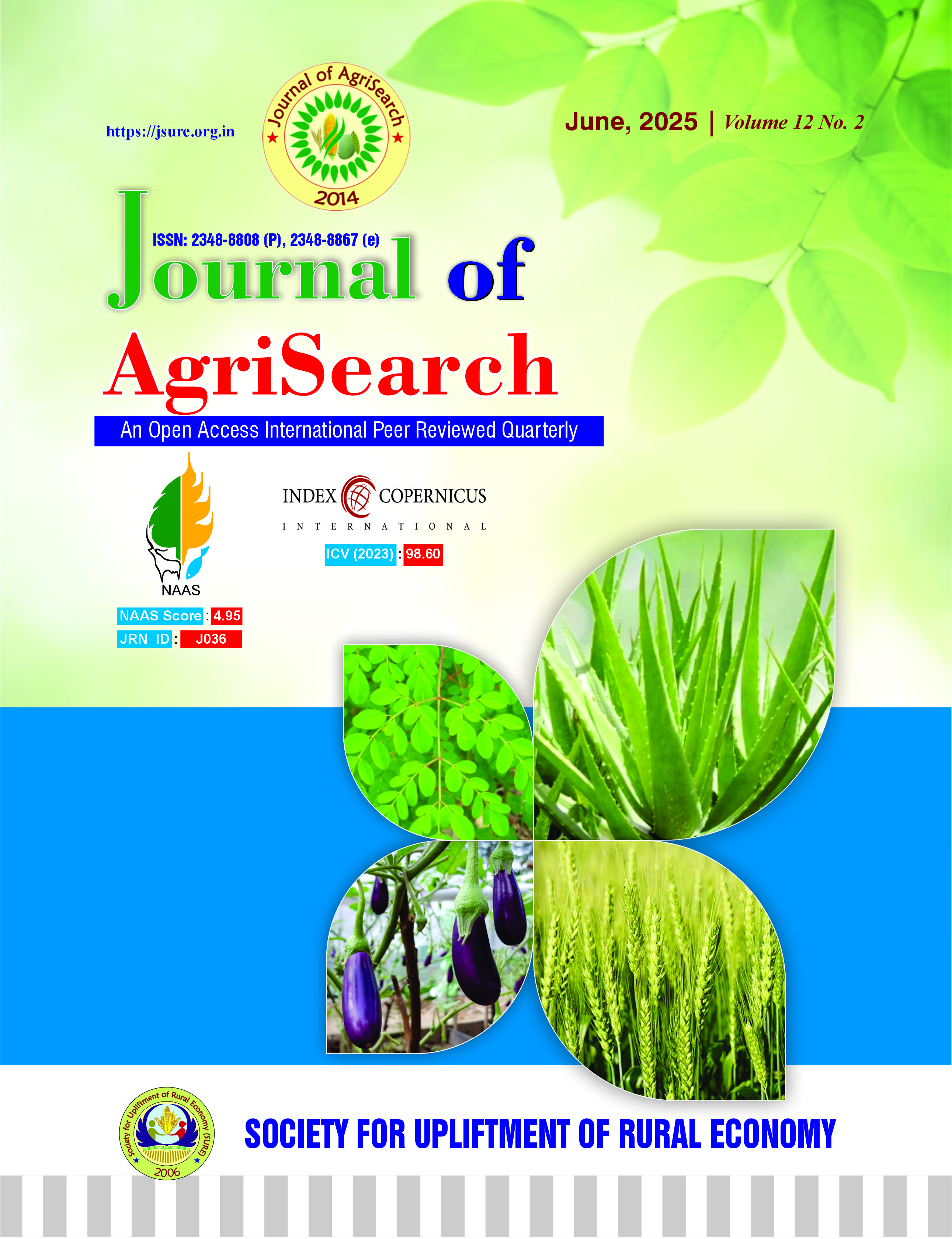Assessing the impact of village adoption programmes on agricultural production and farmers' income
Impact of village adoption programmes on farmers’ income
DOI:
https://doi.org/10.21921/jas.v12i02.15241Keywords:
Village adoption, Yield enhancement, Profitability, Drought tolerance, Vegetable production, Climate-resilient agricultureAbstract
The Village Adoption Programme plays a crucial role in showcasing the benefits of agro-technologies and promoting their adoption for rural development. From 2019 to 2022, ICAR–Krishi Vigyan Kendra (KVK), Ramgarh, adopted Indrabad village in district Ramgarh Jharkhand with the objective of introducing site-specific interventions to enhance productivity and income. Technologies such as drought-tolerant and disease-resistant crop varieties, integrated pest and nutrient management, and income-generating activities like mushroom cultivation were introduced. The programme resulted in notable yield gains: cereals, pulses, and oilseeds improved by 8.89–38.41%, vegetables by 8.57–28.55%, and oyster mushroom production recorded the highest increase at 44%. Economic analysis revealed significant rises in net returns and benefit-cost ratios, with pigeon pea (2.83), onion (3.33), and tomato (2.9) performing exceptionally well. Varietal replacement and scientific crop management proved effective under drought-prone conditions. These outcomes highlight the potential of participatory village adoption models in advancing climate-resilient, diversified, and sustainable agriculture for improved rural livelihoods.
References
Chandan G H and Padaria R N. 2022. Adoption decision-making behavior of farmers about contingency plans in Datia and Parbhani districts. Mysore Journal of Agricultural Sciences 56(4): 142–147.
FAO. 2020. The state of food security and nutrition in the world 2020. Food and Agriculture Organization of the United Nations, Rome.
Hema Sarat Chandra N, Rudroju V and Mishra O P. 2017. Model villages and village adoption approaches in the developmental arena of rural India: View and review. International Journal of Pure and Applied Bioscience 5(6): 551–557.
ICAR. 2021. Annual report 2020–21. Indian Council of Agricultural Research, New Delhi.
Meena R K, Singh S P and Yadav R S. 2019. Impact of frontline demonstrations on productivity and profitability of pulses under rainfed conditions. Indian Journal of Extension Education 55(1): 40–44.
Mishra P, Sharma A and Verma S. 2021. Drought-tolerant crop varieties: A strategy for climate-resilient agriculture. Journal of Agrometeorology 23(2): 220–227.
Roy A, Kumar V and Jha A. 2022. Economic impact of improved crop technologies on smallholder farmers in eastern India. Agricultural Economics Research Review 35(1): 55–64.
Sadvi P D A, Devi R and Uma Reddy R. 2020. A case study on village adopted by RARS, Polasa, Jagtial. Agriculture Update 15(1–2): 28–30.
Sharma A, Kumari P and Kumar S. 2020. Mushroom cultivation as a sustainable livelihood option for smallholder farmers. International Journal of Agricultural Sciences 12(2): 55–60.
Singh A K, Prasad R and Kumar S. 2020. Performance of drought-tolerant rice varieties under rainfed ecosystem. Oryza 57(1): 37–42.
Singh A K, Gupta V and Prasad R. 2021. Impact of improved varieties on yield and economics of vegetable production in eastern India. Vegetable Science 48(1): 102–108.
Verma S and Singh M. 2022. Economic potential of oyster mushroom cultivation for rural entrepreneurship. Journal of Community Mobilization and Sustainable Development 17(3): 475–482.
Downloads
Published
Issue
Section
License
Copyright (c) 2025 Dr.Indra Jeet

This work is licensed under a Creative Commons Attribution-NonCommercial-NoDerivatives 4.0 International License.
Publisher and Authors

